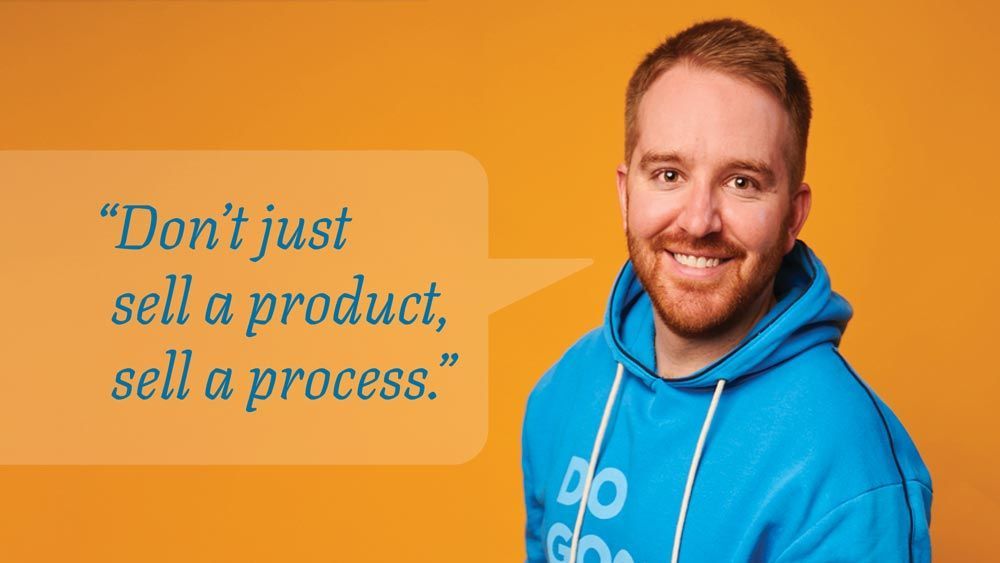Think Like the Customer, Sell More Stuff
When your brand starts thinking like your customer, your marketing and sales will create the ROI your business deserves.
Does it bother you when you’re throwing money at what you think is a marketing problem because you do not see any return on your investment?
Is your sales team complaining that your marketing isn’t attracting or informing customers in a way that makes the sales team’s job easier?
There’s a disconnect between sales and marketing in many businesses. Your website isn’t bringing in any leads, your sales emails aren’t converting, and everyone on your team is telling a different story.
No wonder prospective customers are confused and disinterested.
Three Reasons Why Your Marketing isn’t Working (and How to Fix Them)
Does it feel like marketing is a bottomless pit in your business?
The marketing team scratches their head and wonders why the sales team can’t make better use of the beautiful brochures or website they designed.
Owners and executives are frustrated because profits aren’t growing.
When sales aren’t growing, the sales team thinks marketing is the problem.
There’s probably a bigger problem, and it has to do with your brand strategy.
As an entrepreneur, you understand the importance of driving sales. But if your marketing isn’t getting you any new customers, that’s a problem.
Marketing and sales are partners who need to work together to succeed. They can’t be competitive because when they are both working towards the same goal, success is inevitable!
The need for cooperation between sales and marketing is obvious but overlooked. Sales managers talk about getting better support from the marketing team, but often don’t do anything about it. Marketing keeps creating content that is all about features and benefits instead of focusing on the customer’s problems, solutions to the problems, and how the customer will feel when their problem gets solved.
Your company’s priorities must be supported by aligning the marketing and sales teams with the business strategy and revenue goals. When the entire team pursues shared objectives, it ensures plenty of opportunity for marketing and sales success.
A company’s marketing and sales teams must play a role in supporting the business strategy. The team needs to work together with the executive leadership team to meet revenue goals.
It would be best to create precise alignment on priorities to move forward and be confident that marketing and sales are on the same page.
“With marketing costs increasing and our call counts flat, we took a hard look at our print ads, digital media, television ads,
website, and even our apparel. We were confusing our clients with too many brands, taglines, and messages.”
―
Phil Gorjanc, President
Discover how Gorjanc Home Services solved their revenue problem
Everybody is a Marketer
Everybody in your company is a marketer, but everybody isn’t a salesperson. That’s easy to understand — many people get nervous when asking for a sale or asking for money — but when your brand empowers people to invite people into a story and build a relationship, everybody can a marketer.
After we discussed how brands need to make the customer the hero of the brand story, this VP of sales had a clear directive for their marketing and sales teams:
“I recommend we make our approach less about the product and more about the customer, their goals and problems, and how our brand can help them achieve their goals and overcome their problems.
We know that when we stop talking about the customer and their problems, they stop listening. Brands must stay true to the StoryBrand marketing framework especially when the competition is talking about how great they think their product is (and not how it solves their customer’s problems).”
“Persistent, consistent, and frequent stories, delivered to an aligned audience, will earn attention, trust, and action.”
― Seth Godin, This Is Marketing: You Can't Be Seen Until You Learn to See
Are you still wondering why your marketing isn't working?
It’s not the tactics.
It's the words you use.
You can throw money at digital ads all day — and if your message doesn’t resonate with people and your sales funnel (aka your marketing) doesn’t invite your unique buying tribe into a relationship with your brand and call them to action — you’re wasting your money.
If the message isn't right, it doesn't speak to the mind and touch your tribe’s heart, so nothing happens.
We bond with brands we love when they help us identify as the hero in the story we are part of every day.
Marketing falls short when it only invites people into a story. Marketing must invite people into a relationship with a brand with personality they can know, trust, and love.
People don’t expect brands to be
personal, but they they are attracted to brands with
personality
that demonstrate qualities like
trust in how they do business.
The singular goal of marketing should be to create opportunities for consumers to find a solution to their problems and show them the path to purchasing (and making their life better). It bears repeating: the singular goal of marketing is to create customers.
Branding creates the foundation of empathy and credibility your business needs to earn trust and establish credibility.
Marketing is when you activate the brand in the market by focusing on the buyer and their needs with the words you use.
Building a brand is personal when you position the ideal customer who can fall in love with your brand. this is the point in the relationship where customers (your tribe) create your brand so your brand can sustain your company.
We expect brands to move us from meaning to experience, to transform us into who we want to be.
Product Features and Benefits are Commodities.
Marketing is an expense.
Brand development is an investment.
Your short-term revenue comes from marketing. Your long-term value is in your brand.
It would be best if you had both.
“If you can bring someone belonging, connection, peace of mind, status, or one of the other most desired emotions, you’ve done something worthwhile. The thing you sell is simply a road to achieve those emotions, and we let everyone down when we focus on the tactics, not the outcomes. Who’s it for and what’s it for are the two questions that guide all of our decisions.”
― Seth Godin, This Is Marketing: You Can't Be Seen Until You Learn to See
Is Your Mission the Same as Marketing?
I’ve had two or three conversations this week with prospective clients who wanted to work on their mission statement, which is really for their internal branding perspective.
When professionals struggle to understand the difference and interaction between branding and marketing and how it affects sales, it’s no wonder many leaders don’t understand the difference between their mission, vision, and purpose.
If you ask a member of your buying tribe what they need, they will tell you exactly what they want and how to invite them into a sales conversation.
I felt what they needed instead was to drive leads to their business; to create the customers from their unique buying tribe to generate sales and build their brand. Would you agree? Do people need to focus on marketing before they focus on branding? Or is there a way to pursue those concurrently?
Using Sales to Improve Customer Service
Instead of focusing on constant growth, what if you were laser-focused on managing what you have and improving your current clients’ experience with your brand?
You can talk about clear messaging and beloved brands all you want, but if your product and customer service don’t back up your messaging, you will ruin your reputation and lose business.
What if, instead of pushing out more marketing, you focused your sales team on winning trust?
We’re in the experience and attention economy, and people are overwhelmed. Your unsolicited marketing is an interruption in a time when people crave connection.
“If you come from a sales point of view, it’s all about targets and quotas. It should be fun to sell because it’s so easy.” (Marty Neumeier)
Connect with your customer's needs and desires by giving them a voice. Your marketing is more than just an interruption, it can be the bridge that brings people closer to you and closer together.
Culture is changing and people are overwhelmed. Your marketing might not be the option for which people who are fearful, frustrated, and frantic are looking.
In today’s society, our attention spans are shorter than ever before as we try to filter through all of the noise in order to find what we’re looking fo,r or follow that one piece of content that catches our eye on social media.
What if your marketing offered people release and relief? What if your messaging confidently states, “We have the solution to your problem, and we’re here to help.”
In an experience economy, your brand must stand out from other things vying for attention. Your brand needs to be different. Really different.
The Most Important Brand Touchpoint
The brands and businesses that thrive in the future will focus on people as their primary brand touchpoints.
Marketing doesn’t build relationships.
People do.
The closer your employees are to customers, the more relevant those representing your company are as your brand’s most essential touchpoint.
Are you confident your employees represent your brand, core values, and purpose?
These front-line brand ambassadors will influence how your brand is revered by your tribe and influence how people evangelize for your brand.
Your customers are also key touchpoints. Customers are your external sales team, brand ambassadors, social media influencers, and raving fans!
Building a brand requires that you know your buying tribe’s identity, goals, beliefs, and behaviors because everybody brands, and everybody’s a marketer.
“We’re in a moment where we have so much advertising and everyone’s trying to win in the attention economy, you need to try to win trust.
A way of winning trust is making this deep human connection, which is all about understanding somebody's aspirational goals.”
― Will Leach,
Marketing to Mindstates
Do you have a hard time explaining what your company does or why your brand matters to people?
If you struggle to grow your business, you’re not alone. Aespire can help you create a clear message and brand that helps you grow your business. Contact us today for a consultation with a StoryBrand Certified Marketing Guide.
Get a Free Comprehensive Marketing Assessment
Stop hoping your marketing will sort itself out.
- Complete this free assessment in 15 minutes.
- Review your custom report (and schedule a 30-minute review) to diagnose what’s happening.
- Create an action plan to get your marketing back on track.







